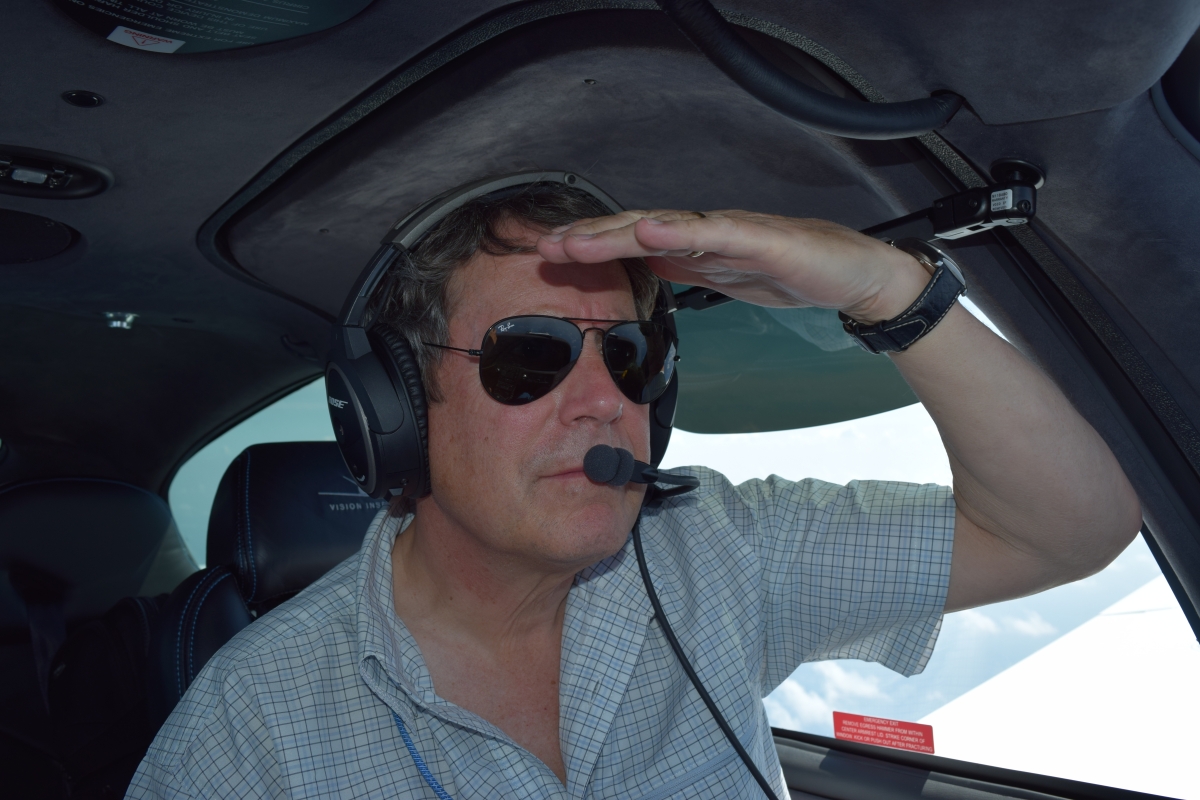
18 Apr Pryor Engagement: LightHawk Travelogue
Telluride local John Pryor is CEO of LightHawk, the nonprofit dedicated to accelerating conservation success through the powerful perspective of flight. Since his tenure with the company is relatively short – he Joined LightHawk just a year ago– John went on a very exciting expedition to Central America and Mexico, using the trip as a way to deepen his understanding of LightHawk’s work in the region and relationships with partners and donors.
“I departed in my Cirrus SR22 from Telluride bound for Merida, Mexico before heading on to Belize, Guatemala and Baja California,” John explained.
R2R: Florida to Mexico
Armando Ubeda stands on the wing of John Pryor’s Cirrus SR22 ready to depart KSRQ for MMMD.
Yesterday, Executive Director John Pryor and Mesoamerica Program Manager Armando Ubeda departed Sarasota, FL (KSRQ) bound 686 mile south for Merida, Yucatan (MMMD). Here are John’s thoughts on the first part of the Rockies to Reef Expedition.
Joining me for the trip is Armando Ubeda who has managed LightHawk’s program in Mexico and Central America for seven years. In addition to being a superlative travel companion, Armando will be introducing me to our conservation partners on each leg of the Expedition.
Necessary gear for the journey includes: life raft, personal life preservers, Mexican/Central American airport guide from Baja Bush Pilots, O2 canulas (needed above 12,000′ when in mountainous terrain or climbing above weather), headsets, EPIRB (Emergency Position Indicating Radio Beacon), umbrella, LightHawk hats, binoculars, POH (pilot operating handbook) and travel documents.
Before heading south, Armando and I met up with Tuck Colby for breakfast. Tuck is a longtime LightHawk board member, volunteer pilot and supporter who lives in Sarasota. As we briefed him on the Rockies to Reef Expedition, he seemed impressed with our plan to share news of this journey to highlight LightHawk’s commitment to conservation in Mexico and Central America. Tuck has seen a lot during his time with LightHawk, so this seal of approval is important.
Ready to depart for Merida, 686 miles away across the Gulf of Mexico.
After departing Sarasota, we fly in radio silence with no air traffic control for two hours between Florida airspace and Mexican airspace. Here I am employing a reliable avionics tool for spotting land ahead. I’m happy to report that our flight was smooth and easy with calm water below.
At last, the coastline appears under the wings of the SR22. After 3 hours and 40 minutes, we land in the capital and largest city in Yucatan state, Merida. A wall of 100 degree heat greets us as we unpack ourselves from the small plane, grateful to stretch our legs, shed our life preservers, and begin the Mexican portion of the Rockies to Reef Expedition by meeting with Rodrigo Migoya and R. Xiomara Galvez of Niños y Crías, A.S. LightHawk partners for about 15 years.
More about LightHawk:
LightHawk’s mission is to accelerate conservation success through the powerful perspective of flight.
We achieve our mission by mobilizing volunteer pilots, photographers, environmental experts, and storytellers to make images, collect data, inform the public and share their experiences. Our flight campaigns foster dialogue and build consensus, promote informed decision-making, and increase the efficiency and effectiveness of our conservation partners’ work.
LightHawk brings coordinated flight campaigns to those working on the ground. We do this through our network of generous supporters and highly skilled volunteer pilots. By making flights available to those working on the ground to protect our natural world, we enable our partners in conservation to quickly and efficiently understand environmental issues and determine the factors needed to promote effective solutions.
More About John Pryor:
John brings his experience with nonprofits, entrepreneurship, business management, venture capital investment, and politics to LightHawk where he began as executive director in April 2014. He spent 15 years working with Telluride Venture Partners, an early stage investment group and also worked for Anixter, a large international telecommunications equipment supply company. John holds a degree in environmental conservation from the University of Colorado and has been an active land conservationist as a board member of Colorado’s Nature Conservancy. A highlight of his TNC experience included living in Argentina for a year where he worked to help establish their new office. John is also a councilor at Manomet Center for Conservation Science near Plymouth, MA. He learned to fly in Telluride, CO, earned an instrument rating, and now flies a Cirrus SR22T. As mayor of Telluride for four years, he had great success in saving Telluride’s Valley Floor by raising a significant amount of public and private funds. John is a cyclist, skier, sailor and also enjoys bee keeping.









Nancy carney
Posted at 17:57h, 02 DecemberLove the work you are doing! Working on water conservation and bee keeping too.concerned with water quality from mississippi to gulf of mexico, specically involving water from lake okajobi to the pine island sound. Land owner on sanibel island. It was really cool to see that you are doing such great work! Nancy